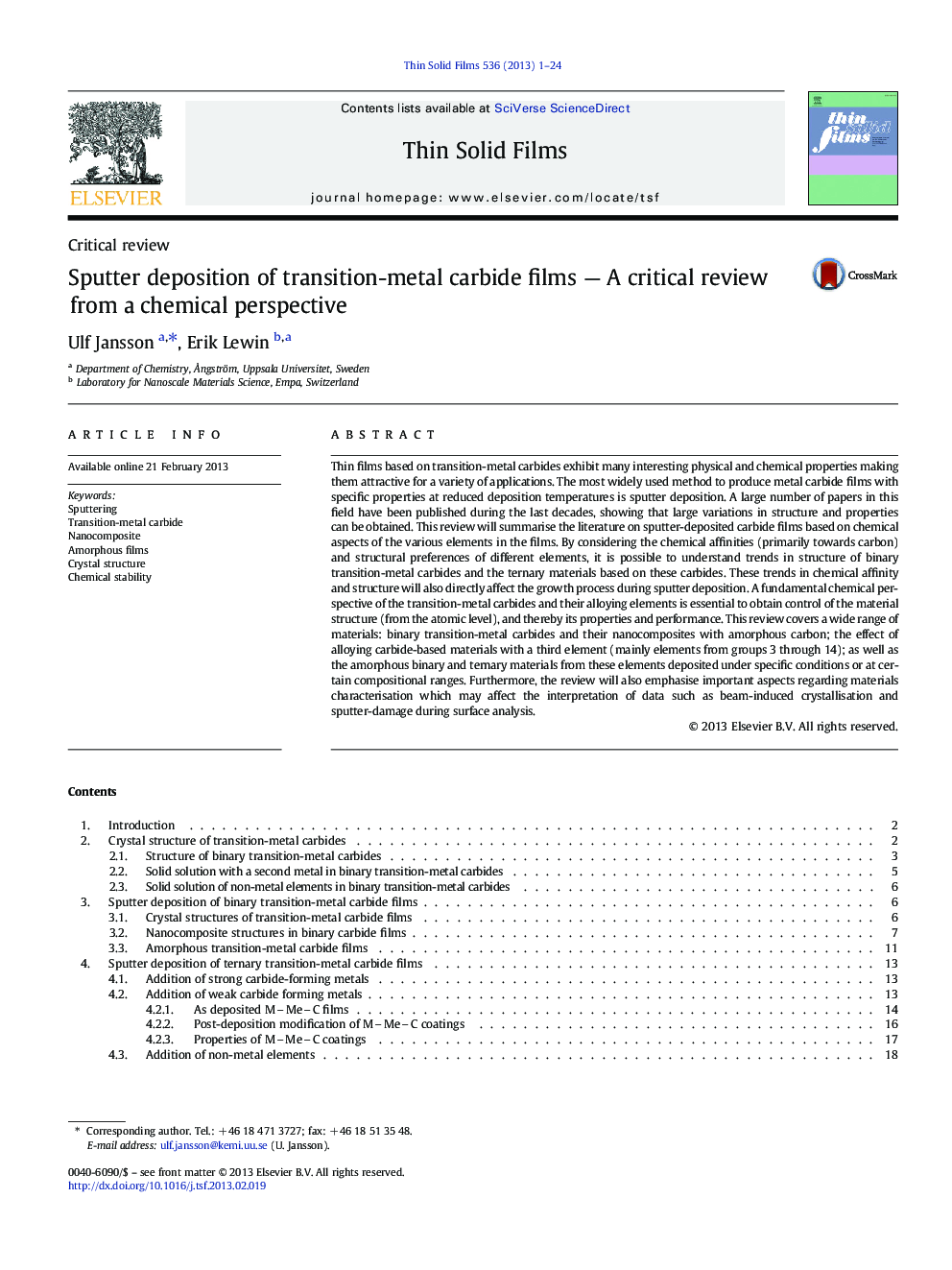| کد مقاله | کد نشریه | سال انتشار | مقاله انگلیسی | نسخه تمام متن |
|---|---|---|---|---|
| 8036526 | 1518068 | 2013 | 24 صفحه PDF | دانلود رایگان |
عنوان انگلیسی مقاله ISI
Sputter deposition of transition-metal carbide films - A critical review from a chemical perspective
ترجمه فارسی عنوان
رسوب شونده از فیلم های کاربید فلز انتقالی - بررسی انتقادی از دیدگاه شیمیایی
دانلود مقاله + سفارش ترجمه
دانلود مقاله ISI انگلیسی
رایگان برای ایرانیان
کلمات کلیدی
کندوپاش، فلز کاربید ترانزیت، نانوکامپوزیت، فیلم های آمورف، ساختار کریستالی، پایداری شیمیایی،
ترجمه چکیده
فیلم های نازک بر اساس کاربید های فلز انتقالی، بسیاری از خواص فیزیکی و شیمیایی جالب را به نمایش می گذارند و آنها را جذاب می سازد. به طور گسترده ای برای تولید فیلم های کاربید فلزی با خصوصیات خاص در کاهش درجه حرارت رسوب، رسوب دگرسانی است. تعداد زیادی از مقالات در این زمینه در دهه های اخیر منتشر شده است، که نشان می دهد که تغییرات زیادی در ساختار و خواص می تواند به دست آید. این بررسی ادبیات مربوط به فیلمهای کاربید سپری شده بر پایه جنبه های شیمیایی عناصر مختلف فیلم را خلاصه می کند. با در نظر گرفتن وابستگی های شیمیایی (عمدتا به سمت کربن) و ترجیحات ساختاری عناصر مختلف، می توان در روند ساختار کاربید های ترانسفورماتیکی باینری و مواد ترمیمی بر اساس این کاربید ها درک کرد. این روند در ساخت و ساز مواد شیمیایی نیز به طور مستقیم بر روند رشد در هنگام رسوب اسپری تاثیر می گذارد. یک دیدگاه شیمیایی پایه ای از کاربید های فلزات انتقالی و عناصر آلیاژ آنها برای رسیدن به کنترل ساختار مواد (از سطح اتمی) و به این ترتیب خواص و عملکرد آن ضروری است. این بررسی طیف گسترده ای از مواد را شامل می شود: کاربید های ترانس فلزات دوتایی و نانوکامپوزیت های آنها با کربن آمورف؛ اثر آلیاژ کاربید بر اساس مواد با عنصر سوم (به طور عمده عناصر از گروه 3 تا 14)؛ و همچنین مواد دوتایی و سه بعدی آمورف از این عناصر تحت شرایط خاص یا در محدوده های ترکیب خاصی قرار می گیرند. علاوه بر این، بررسی همچنین بر جنبه های مهم در خصوص ویژگی های مواد تأکید می کند که ممکن است بر تفسیر داده ها نظیر بلورینگی ناشی از پرتو و خسارت ناگهانی در تجزیه سطح تاثیر داشته باشد.
موضوعات مرتبط
مهندسی و علوم پایه
مهندسی مواد
فناوری نانو (نانو تکنولوژی)
چکیده انگلیسی
Thin films based on transition-metal carbides exhibit many interesting physical and chemical properties making them attractive for a variety of applications. The most widely used method to produce metal carbide films with specific properties at reduced deposition temperatures is sputter deposition. A large number of papers in this field have been published during the last decades, showing that large variations in structure and properties can be obtained. This review will summarise the literature on sputter-deposited carbide films based on chemical aspects of the various elements in the films. By considering the chemical affinities (primarily towards carbon) and structural preferences of different elements, it is possible to understand trends in structure of binary transition-metal carbides and the ternary materials based on these carbides. These trends in chemical affinity and structure will also directly affect the growth process during sputter deposition. A fundamental chemical perspective of the transition-metal carbides and their alloying elements is essential to obtain control of the material structure (from the atomic level), and thereby its properties and performance. This review covers a wide range of materials: binary transition-metal carbides and their nanocomposites with amorphous carbon; the effect of alloying carbide-based materials with a third element (mainly elements from groups 3 through 14); as well as the amorphous binary and ternary materials from these elements deposited under specific conditions or at certain compositional ranges. Furthermore, the review will also emphasise important aspects regarding materials characterisation which may affect the interpretation of data such as beam-induced crystallisation and sputter-damage during surface analysis.
ناشر
Database: Elsevier - ScienceDirect (ساینس دایرکت)
Journal: Thin Solid Films - Volume 536, 1 June 2013, Pages 1-24
Journal: Thin Solid Films - Volume 536, 1 June 2013, Pages 1-24
نویسندگان
Ulf Jansson, Erik Lewin,
